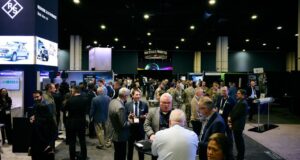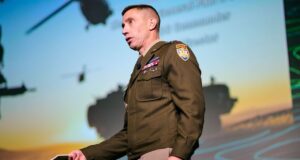Industry Partners Making Progress on GCAP EW and Avionics Flight Testing

Design and development of the Integrated Sensing and Non Kinetic Effects (ISANKE) & Integrated Communications System (ICS) belonging to the Global Combat Air Program (GCAP) will begin by the end of the year, industry program officials have suggested. Speaking to JED at the DSEI Japan expo in Tokyo in late May, company executives from ELT Group, Leonardo Italia, Leonardo UK and Mitsubishi Electric Corporation discussed the current state of the program, which aims to deliver a sixth-generation combat air platform to Italy, Japan and UK by 2035.
Critical to the ISANKE & ICS capabilities of the GCAP is the Multi-Function Radio Frequency System (MRFS) – initially a UK Technology Development Program (TDP) for the Royal Air Force’s “Tempest” program. Previously, company executives at Leonardo UK have described the MRFS program as an evolution of the ECRS Mk2 radar, which took to the skies for the first time in September 2024 on board a Royal Air Force Typhoon.
However, according to Leonardo UK’s Director, Future Combat Air, Andrew Howard, the UK TDP was better understood as an attempt to learn from the ECRS Mk2 and take it to the next level of iteration. “So there’s been a TDP program schedule that was always expected to reach a level of maturity until the 2026/2027 timeframe,” he said. “That remains the case. That’s a key building block of our overall program. Obviously, there’s a large number of technologies and sensors that we’re anticipating developing in general but we’re not on the critical path at this point for any of our technology. So in terms of the headroom that we enjoy in delivering the sensor and communication system, we’re pretty comfortable that we’re working within the umbrella of the airframe and the propulsion, and that the tech maturity of MRFS in particular is maturing in line with our with our expectations.”
“And obviously,” he continued, “the difference now is that MRFS, which was borne out of a UK TDP, will evolve into a future radar for the GCAP platform with our international partners who’ll be making large contributions. So that is maturing in line with our view and against the timelines,” he added.
Little is known about the exact specifications of the MRFS, but Leonardo UK literature describes it as being capable of providing “over 10,000 times more data than existing systems,” including an extensive range of electromagnetic spectrum operations (EMSO) capabilities.
Pietro Vanotti, Senior Vice President, Future Combat Air Systems at Leonardo Electronics Italy, confirmed technologies associated with ISANKE & ICS are “continuously improving and therefore maturing even more because of GCAP requirements which are much more demanding than Eurofighter requirements.” As an example, Vanotti highlighted GCAP’s different Infrared Search and Track (IRST) system, which he described as possessing the ability to “track targets in a fully passive mode – one of the key features that we wanted to continue to improve.” Vanotti also described cooperation between “Infrared sensor and radio frequency sensors, all acting together. That combination together with the ability to fuse the information of such kinds of systems is one of the most important aspects,” he continued.
Flight Tests
Initial prototypes of the MRFS will first take to the skies on board the GCAP technology demonstrator. But ahead of that, executives from across the ISANKE & ICS alliance described aspirations to “harmonize” flight test data, currently being conducted on board larger air frames at unilateral levels by Italy, Japan and the UK.
In the UK, the Excalibur Flight Test Aircraft (an upgraded Boeing 757 aircraft) continues to be modified ahead of integration of the MRFS into the nose section of the aircraft. Excalibur is then expected to begin flight tests in 2026.
“The Excalibur FTA ambition is to conclude UK TDPs, remove those TDPs, refit with the final agreed work allocation outcomes with the maturing sensors at what we might call the GCAP International Standard and run a period of flight tests predominantly focused on sensor fusion and data exchange for data links in that area, in that period, that allows us to sort of really prove the integration capabilities of the sensors in a large aircraft environment, where we can make real time changes in airborne laboratory space,” Howard explained. “We can test work alongside the Flight Test Laboratory (FTL) as a surrogate platform that provides the means to share data in an airborne test environment. There’s also a recognition of a need for a level of redundancy and risk redundancy and risk management by having several platforms, which collectively will serve to de-risk the macro program schedule, because ultimately we’ll conclude the airborne test and accreditation of the central solution on a fast jet, as was the case on all previous similar platforms like Typhoon where the space, the heat, the light, the vibration, will be materially different to the large [test]aircraft.”
Howard continued: “So the intent is to bring that together as a global test set in flight testing, share a data program with the [Japanese Flight Test Bed] and recognize there are some subtle differences between those two things, but also some security practicalities of moving large aircraft with cutting edge sensors around the world. So it makes quite a lot of sense to have a platform in both Japan and the UK with close alignment with the Italian platform, which is also a de-risker to generate more integrated flight test solutions. When we look at the integrated test and evaluation plan today, it positively anticipates the role of the three platforms and the pyramid into the fast jet,” Howard said, confirming fast jet trials of the MRFS will be conducted on board the GCAP technology demonstrator aircraft.
Vanotti was unable to disclose the name of Italy’s FTL platform due to ongoing commercial agreements with the supplier, but he added, “It’s important to demonstrate the distributed capabilities. In order to demonstrate the distributed capability, that is one of the goals of the integrated system, because we have to see the system as a unique, big, distributed sensor. “We need to have more than just a single sensor,” he explained. “Of course, the key platform, that is the reference platform at the end, it will be the Excalibur FTA. However, the FTA will be exercised together with the FTB and together with the FTL in order to check the possibility to sense the same target, the same scenario, but with a number of distributed higher capabilities. This is exactly the role, other than, of course, to support the maturity of each nation for its own part of the program.”
Mitsubishi Electronics’ General Manager, GCAP Department, Masahiro Suzuki, confirmed Japan has been conducting GCAP-related flight testing with C1 and C2 airframes. “In talking about GCAP in Japan, it does include some digital transformation,” he said. “However, not everything may be flight tested, but there are portions that need to be flight tested, and for that purpose, the C2 has been leading efforts by Ministry of Defense of Japan. So each country has its flight test aircraft, but how do we evaluate based on that? This is something that we need to consider among the three nations, and how we can use [them]to make the evaluation,” he said.
CCAs
The industry executives also discussed the potential for the ISANKE & ICS consortium to design specialized payloads capable of being integrated on board collaborative combat aircraft (CCA) or “loyal wingmen.” As part of the GCAP roadmap,” Howard said, “ISANKE & ICS sub-systems on the GCAP aircraft are required to communicate with CCAs, not necessarily furnish them with radar and IRST systems for example. “I think the unique nature of what we do is obviously the collection of technologies that are intrinsically more capable than before. So clearly, unlike the airframe and the engine, the sensor technologies that we’re developing are transferable from the current construct of our program.”
He continued: “So the joint venture and the consortium, at the moment are focused on the core platform. The expectation is that these aircraft exist to command and control multiple different types of CCAs. And it’s clear that each of the nations has – at least for the time being – a level of differentiated view on the nature of the need, the size and the capabilities of a CCA they might work with. So whether you’re talking about data links, whether you’re talking about sensor integration, whether you’re simply talking about radar technology, we see it as transferable technologies that we like to apply.”
“So clearly, from a commercial motivation,” Howard added, “we are keen to try and leverage our capabilities onto adjuncts or CCAs. From a military capability perspective, we think that we can create a highly optimized interface. So the simple answer is yes. But in terms of ‘is there a single GCAP requirement that we’re responding to where our technology will simply transfer onto a predetermined adjunct that each nation may use?’ That’s definitely not the case at this time,” he explained.
Finally, ELT Group’s Senior Vice President for Future Business and Public Financing, Alberto de Arcangelis, described how GCAP’s ISANKE & ICS must communicate with not only fourth- and fifth-generation aircraft but also with uncrewed aircraft. “That, for sure, will be part of the mission,” he said, “and they will be able to fly together with the core platform. Each nation, maybe, will have its own kind of CCA, but it is mandatory that ISANKE & ICS is designed in order to distribute information towards all these platforms.” – Andrew White






